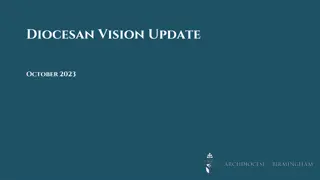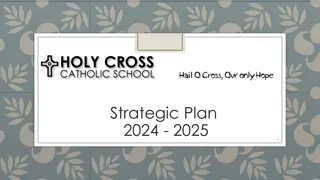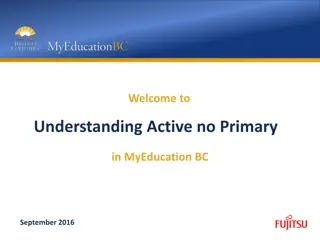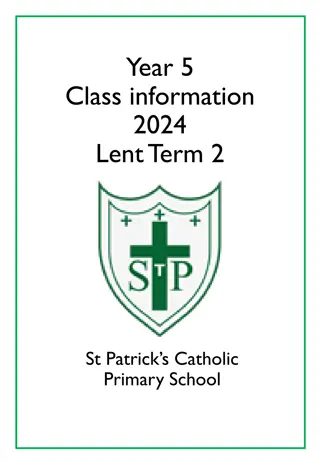Mathematics Bridging Course Highlights from Tseung Kwan O Catholic Primary School
In the Mathematics Bridging Course for the Secondary Curriculum at Tseung Kwan O Catholic Primary School, students are introduced to important terms related to directed numbers, such as positive and negative numbers, absolute value, and numerical comparisons. The course covers fundamental concepts like the opposite number, numerical operations, and practical exercises to enhance understanding. Students engage in group activities, tests, and class practice sessions to reinforce learning and prepare for more advanced math concepts.
Download Presentation

Please find below an Image/Link to download the presentation.
The content on the website is provided AS IS for your information and personal use only. It may not be sold, licensed, or shared on other websites without obtaining consent from the author.If you encounter any issues during the download, it is possible that the publisher has removed the file from their server.
You are allowed to download the files provided on this website for personal or commercial use, subject to the condition that they are used lawfully. All files are the property of their respective owners.
The content on the website is provided AS IS for your information and personal use only. It may not be sold, licensed, or shared on other websites without obtaining consent from the author.
E N D
Presentation Transcript
Tseung Kwan O Catholic Primary School 2019-2020 Mathematics Bridging Course For Secondary Curriculum
Group A Members Aaron Hui Edward Deng Jay Yim Kenton Kom Sunny Ng
Important Terms P.16 Term Chinese Term Chinese Translation Translation Directed number Number line Integer Positive number Inverse process Signed number Negative number Zero
2.1 Introduction to Directed Numbers Number which carry positive signs + or negative signs are called directed numbers( ). (a) Positive numbers ( ) are numbers greater than 0. e.g. +4, +11, +0.4 , +0.88 (b) Negative numbers ( ) are numbers smaller than 0. e.g. 4, 11, -0.4, -0.88
Notes (i) Every directed number has a number which is opposite to it. e.g. The number opposite to 6 is +6. The number opposite to +7 is 7. A directed number and the number opposite to it have the same numerical value but different signs. (ii) We can sometimes omit the + sign attached to a positive number, but the sign attached to a negative number cannot be omitted. (iii) The numerical value itself does not carry a positive sign or a negative sign, and we usually call it the absolute value . (iv) The symbol > means is greater than , and the symbol < means is less than . e.g. 4 < 6 < 9 < 13 5 > 3 > -1 > -3
Test one for P.16 1. What means in English? 2. We have two kinds of number. Positive number ( ) and ___________________(______). Negative number Integer 3. Number which carry positive signs + or negative signs are called __________________(______). 4. Positive numbers ( ) are numbers ________ than 0. 5. Negative numbers ( ) are numbers _______ than 0. Directed number greater smaller
Test two for P.16 Please write the opposite number. 78 1. -78, ___ 2. -5, ___ 5 -123 3. +123, ___ -893 4. +893, ___ Answer the questions. 5. Can we omit the + sign attached to a positive number? Yes, we can. 6. Can we omit the - sign attached to a negative number? No, we can t.
Class practice in P.17 Part 1 1(a) 10 ; 10 1(b) 24 ; -24 1(c) below ; -30 1(d) above ; 18 Nothing to see here... Just kidding, I have a secret for you guys. If one of you guys can be the fastest and get all correct, that person can get a special gift!
Class practice in P.17 Part 2 Use positive numbers to represent gains in weight and negative numbers to represent losses in weight and answer the following questions. (a) Use directed numbers to represent the following situations. +1 +3 +10 +10 A gain of 1 kg in weight _______ A gain of 3 kg in weight _______ A gain of 10 kg in weight _______ Of the gains mentioned in part (a), which is the greatest? Use directed numbers to represent the following situations. -1 A loss of 1 kg in weight _______ -4 A loss of 4 kg in weight _______ -8 A loss of 8 kg in weight _______
2.2 Ordering Directed Numbers on the Number Line We can mark the directed numbers on a straight line in ascending order of magnitude. The straight line is called a number line ( ) and it can be either vertical or horizontal. Vertical number line (on the right side of the blackboard) Horizontal number line (on the left side of the blackboard)
Note of P.18 (i) The arrow on the number line indicates the direction in which the values of the numbers are increasing. (ii)The position of 0 on the number line is the boundary between positive and negative numbers. We notice that for a number on a vertical number line, the lower down its position, the smaller its value; the higher up its position, the higher its value. We notice that on a horizontal number line, the further to the left its position, the smaller its value; the further to the right its position, the larger its value. Directed numbers can be represented on the number line. All the points are equally spaced on the number line. Positive numbers are on the right of 0 and negative numbers are on the left of 0.
Test for P.18 1. The arrow on the number line indicates the direction in which the values of the numbers are ____________. increasing boundary 2. The position of 0 on the number line is the __________ between positive and negative numbers. lower 3. We notice that for a number on a vertical number line, the ______ down its position, the smaller its value; the ________ up its position, the higher its value. higher left 4. We notice that on a horizontal number line, the further to the ___ its position, the smaller its value; the further to the _____ its position, the larger its value. right
Class practice 2 in P.19 1. Arrange the following numbers in ascending order ( ) of magnitude. (a) +1, 2, +3, +6 2 < < < +1 +3 +6 (b)+5, 4, +3, 1 < < < -4 -1 +3 +5 (c) 3, 1, 0, 7, +2 < < < < -7 -3 -1 0 +2
Class practice 2 in P.19 2.Arrange the following numbers in descending order ( ) of magnitude. (a) 3, +1 +3, 0 +3 > > > +1 0 -3 (b) +11, 1, 5, +8 > > > +11 +8 -1 -5 (c) 6, 7, 12, +4 > > > +4 -6 -7 -12
Class practice 2 in P.19 3. Look at the horizontal number line on the blackboard, answer the question. A= B= C= D= -3 -2 +1 +4 4. Put the correct symbol between each pair of numbers below. < < (a) + 6m ____ + 15m ____ + 120m > > (b) + 11kg ____ + 2kg ____ + 1kg (c) -6m ____ -15m ____ -120m > > (d) -8kg ____ -3kg ____ -1kg < <
Answer of class practice 2 1. (a) -2 < +1 < +3 < +6 2. (a) +3 > +1 > 0 > -3 (b) -4 < -1 < +3 < +5 (b) +11 > +8 > -1 > -5 (c) -7 < -3 < -1 < 0 < +2 (c) +4 > -6 > -7 > -12 3. A= -3 B= -2 C= +1 D= +4 4. (a) + 6m < + 15m < + 120m (b) + 11kg > + 2kg > + 1kg (c) -6m > -15m > -120m (d) -8kg < -3kg < -1kg
This is the end of our presentation, hope it can help you!























